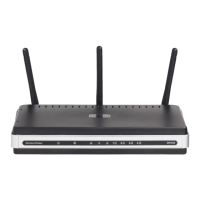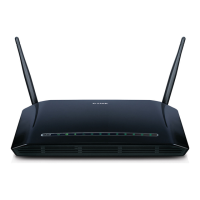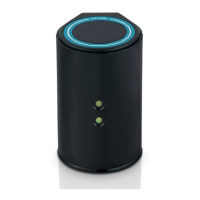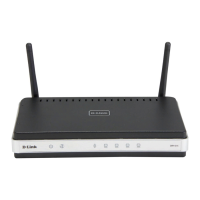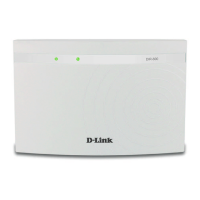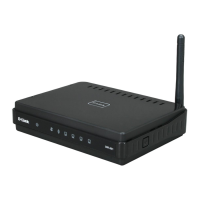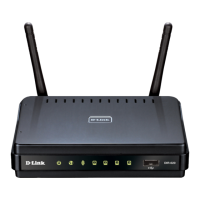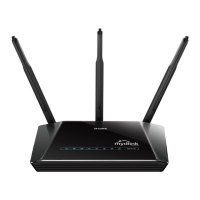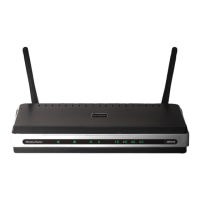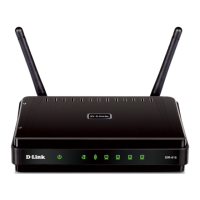Do you have a question about the D-Link DIR 635 B3 and is the answer not in the manual?
Details changes made to the manual over time.
Lists D-Link and third-party trademarks.
Lists all items included in the router package.
Outlines the necessary hardware and software for setup.
Describes the physical ports on the router and their uses.
Explains the function of each LED indicator on the router.
Provides preparatory steps and important notes before installation.
Offers guidelines for optimal wireless signal placement and performance.
Step-by-step guide for connecting the router to a modem.
Instructions for connecting the router to an existing network.
Guides users through the initial setup process using the wizard.
How to access and use the router's web interface for settings.
Step-by-step guide for configuring the router's internet connection.
Instructions for manually configuring internet connection settings.
Details on setting up Dynamic IP (DHCP) for cable connections.
Instructions for setting up PPPoE (DSL) internet connections.
Instructions for setting up PPTP internet connections.
Overview of wireless configuration options and wizards.
Detailed steps for manually configuring wireless network parameters.
How to change local network settings and configure DHCP.
Configuration options for the router's DHCP server.
How to assign static IP addresses to specific devices.
Configuration options for the router's USB port.
How to configure the router as a virtual server for remote access.
Instructions for opening single or multiple ports for network traffic.
How to prioritize network traffic for better performance.
Using MAC addresses to allow or deny network access.
Control network access using parental controls or time-based rules.
How to create lists of allowed or blocked websites.
Configure rules to control inbound data based on IP address ranges.
Options for configuring the router's firewall protection.
Enable or disable ALGs for special protocol handling.
Customize specific routes for data traffic through the network.
Adjust advanced wireless parameters for optimal performance.
Prioritize wireless traffic for different applications.
Simplified method for securing wireless networks and adding devices.
Change administrator/user passwords and enable remote management.
Set the router's time zone, NTP server, and Daylight Saving.
Configure logging and sending logs to a SysLog server.
Configure email notifications for logs and firmware updates.
Save, load, or restore router configuration settings.
Instructions for updating the router's firmware.
Set up Dynamic DNS to host a server with a changing IP address.
Perform ping tests to check network connectivity.
Create schedules for firewall and parental control rules.
Displays current LAN, WAN, and Wireless connection details.
View and manage router event logs.
View traffic statistics for Internet and LAN ports.
Displays details of active internet sessions to the router.
Displays a list of currently connected wireless clients.
Explains different levels of wireless security options.
Guides through setting up wireless network security.
Explains the WPA standard and its improvements over WEP.
Steps for connecting to a wireless network using Windows Vista.
Steps to configure wireless security settings on your adapter.
Setup instructions for Wi-Fi Protected Setup (WCN 2.0).
Guide for connecting to a wireless network with Windows XP.
Steps to configure WPA-PSK security for wireless adapters.
Steps to reset and configure internet settings to troubleshoot.
Procedure to reset the router if the password is forgotten.
Solutions for not being able to access the router's web interface.
Troubleshooting steps for connectivity issues, suggesting MTU adjustments.
Explains the two primary modes of wireless networking: Infrastructure and Ad-Hoc.
Steps to verify the computer's IP address and network configuration.
Guide for manually assigning a static IP address to a network adapter.
Details changes made to the manual over time.
Lists D-Link and third-party trademarks.
Lists all items included in the router package.
Outlines the necessary hardware and software for setup.
Describes the physical ports on the router and their uses.
Explains the function of each LED indicator on the router.
Provides preparatory steps and important notes before installation.
Offers guidelines for optimal wireless signal placement and performance.
Step-by-step guide for connecting the router to a modem.
Instructions for connecting the router to an existing network.
Guides users through the initial setup process using the wizard.
How to access and use the router's web interface for settings.
Step-by-step guide for configuring the router's internet connection.
Instructions for manually configuring internet connection settings.
Details on setting up Dynamic IP (DHCP) for cable connections.
Instructions for setting up PPPoE (DSL) internet connections.
Instructions for setting up PPTP internet connections.
Overview of wireless configuration options and wizards.
Detailed steps for manually configuring wireless network parameters.
How to change local network settings and configure DHCP.
Configuration options for the router's DHCP server.
How to assign static IP addresses to specific devices.
Configuration options for the router's USB port.
How to configure the router as a virtual server for remote access.
Instructions for opening single or multiple ports for network traffic.
How to prioritize network traffic for better performance.
Using MAC addresses to allow or deny network access.
Control network access using parental controls or time-based rules.
How to create lists of allowed or blocked websites.
Configure rules to control inbound data based on IP address ranges.
Options for configuring the router's firewall protection.
Enable or disable ALGs for special protocol handling.
Customize specific routes for data traffic through the network.
Adjust advanced wireless parameters for optimal performance.
Prioritize wireless traffic for different applications.
Simplified method for securing wireless networks and adding devices.
Change administrator/user passwords and enable remote management.
Set the router's time zone, NTP server, and Daylight Saving.
Configure logging and sending logs to a SysLog server.
Configure email notifications for logs and firmware updates.
Save, load, or restore router configuration settings.
Instructions for updating the router's firmware.
Set up Dynamic DNS to host a server with a changing IP address.
Perform ping tests to check network connectivity.
Create schedules for firewall and parental control rules.
Displays current LAN, WAN, and Wireless connection details.
View and manage router event logs.
View traffic statistics for Internet and LAN ports.
Displays details of active internet sessions to the router.
Displays a list of currently connected wireless clients.
Explains different levels of wireless security options.
Guides through setting up wireless network security.
Explains the WPA standard and its improvements over WEP.
Steps for connecting to a wireless network using Windows Vista.
Steps to configure wireless security settings on your adapter.
Setup instructions for Wi-Fi Protected Setup (WCN 2.0).
Guide for connecting to a wireless network with Windows XP.
Steps to configure WPA-PSK security for wireless adapters.
Steps to reset and configure internet settings to troubleshoot.
Procedure to reset the router if the password is forgotten.
Solutions for not being able to access the router's web interface.
Troubleshooting steps for connectivity issues, suggesting MTU adjustments.
Explains the two primary modes of wireless networking: Infrastructure and Ad-Hoc.
Steps to verify the computer's IP address and network configuration.
Guide for manually assigning a static IP address to a network adapter.
| humidity | 95% maximum (non-condensing) |
|---|---|
| operating temperature | 0°C to 40°C (32°F to 104°F) |
| frequency range | 2.4GHz to 2.483GHz |
| power input voltage | 5 VDC |
|---|---|
| power input current | 2.5A |
| external antenna type | Three detachable reverse SMA Antennas |
| dimensions | 116.84 x 193.04 x 30.48 mm |
|---|---|
| weight | 368.3 grams |

